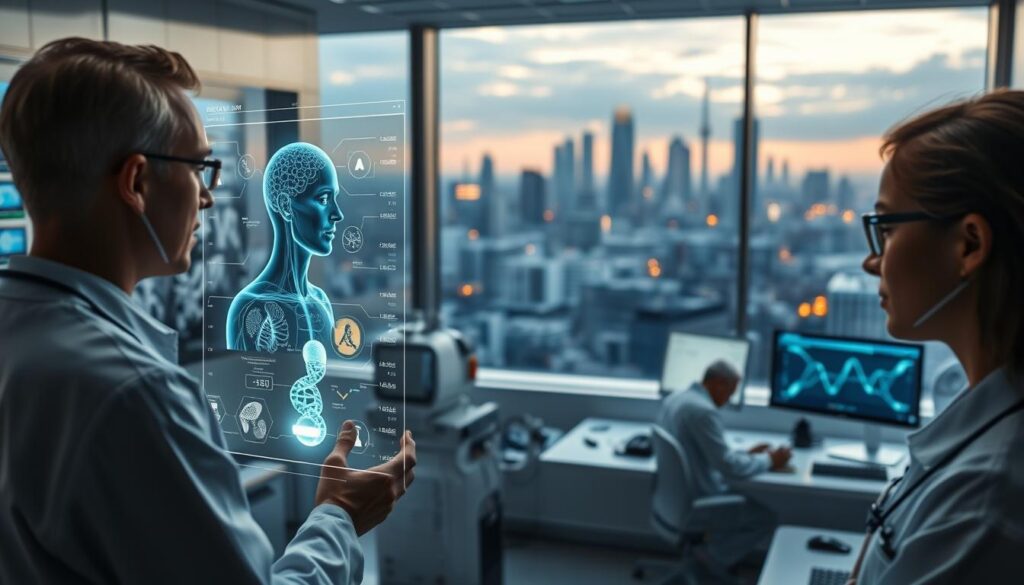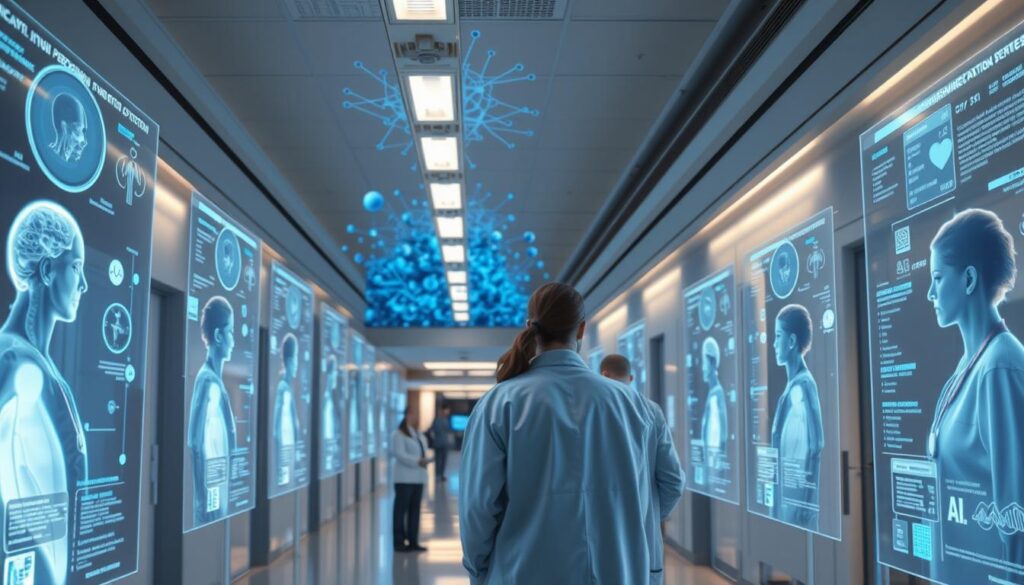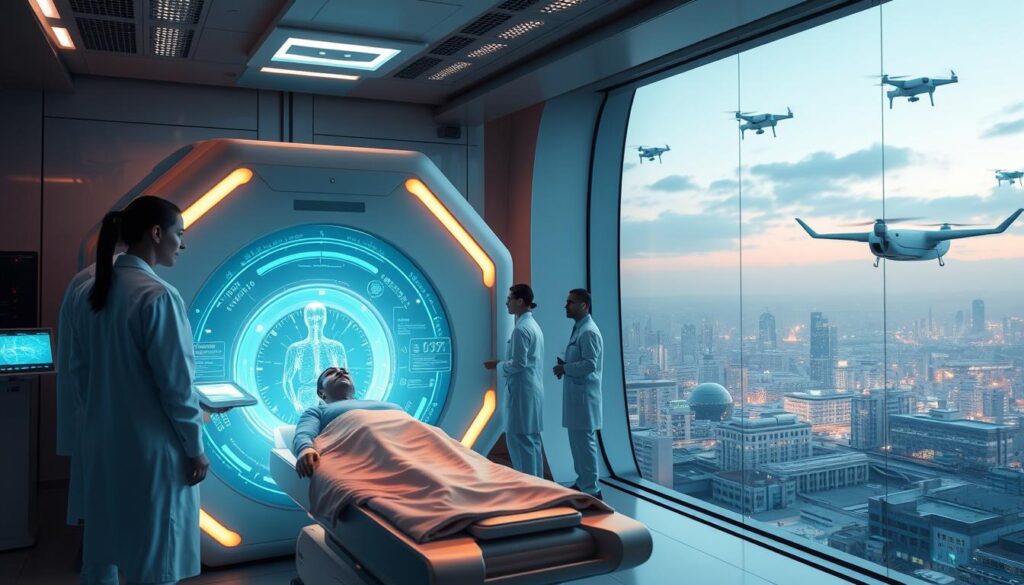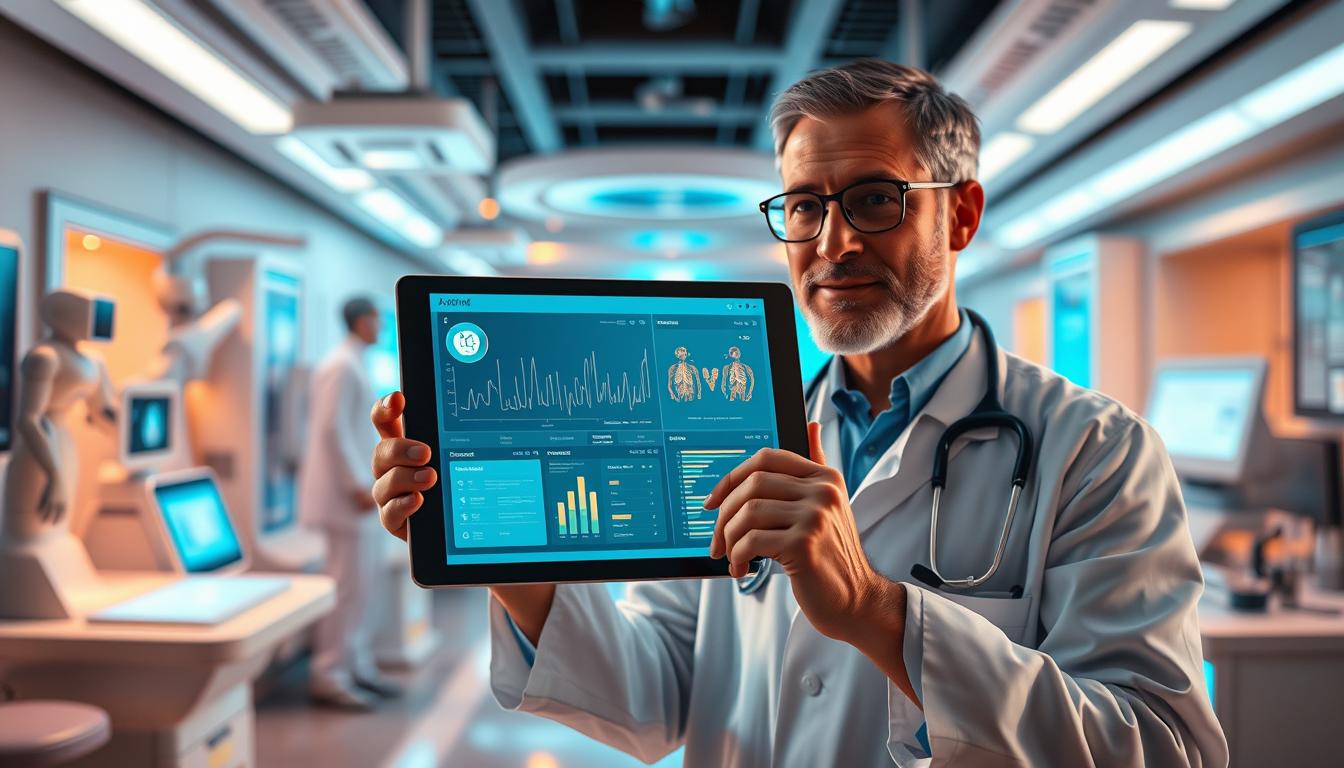Did you know that AI-driven diagnostics can reduce medical errors by up to 30%? This breakthrough is reshaping how doctors deliver care, making treatments faster and more accurate. Artificial intelligence now tailors solutions to individual needs, turning data into life-saving insights.
Modern health systems rely on AI to analyze vast amounts of patient data. Companies like GE HealthCare lead the charge with precision care tools. These innovations help hospitals predict risks and customize treatments like never before.
From early disease detection to optimized recovery plans, AI bridges gaps in traditional medicine. This article explores how smart technology is transforming patient outcomes—and what’s next for the industry.
Introduction to AI in Healthcare
AI has become a game-changer in modern health care. It powers everything from diagnostics to administrative tasks, making systems faster and more accurate. Hospitals now use AI to analyze patient data, predict risks, and customize treatments.

How does AI fit into medical systems? It supports decision-making by processing vast amounts of data. For example, UnitedHealthcare combines AI with personalized support to simplify patient experiences. Their model reduces paperwork and speeds up approvals.
Key AI applications include:
- Diagnostics: Detecting diseases early with image analysis.
- Administration: Automating claims and scheduling.
- Patient Monitoring: Tracking vitals in real time.
Data-driven insights also improve affordability. AI helps patients navigate insurance information and coverage options. This transparency lowers costs and boosts accessibility.
With AI, health systems deliver quality care while cutting inefficiencies. The future promises even smarter tools for personalized treatment.
The Role of AI in Personalized Medicine
AI turns patient data into precise, life-changing care plans. By analyzing genetic codes, medical histories, and real-time vitals, it uncovers patterns humans might miss. This precision helps doctors deliver treatments tailored to each individual’s needs.

How AI Analyzes Patient Data
Machine learning algorithms process vast datasets, from genomes to past treatments. For example, UnitedHealthcare’s member app uses AI to sync health records, lab results, and insurance details. It flags risks and suggests care steps, simplifying coordination.
GE HealthCare’s imaging systems take this further. Their AI scans MRIs or X-rays to detect subtle anomalies. This speeds up diagnoses and reduces human error.
Customizing Treatment Plans with AI
AI doesn’t just diagnose—it predicts. Models forecast how patients will respond to medications or therapies. Hospitals using these tools see fewer readmissions. One study showed AI-optimized plans cut recovery times by 20%.
Key innovations include:
- Predictive alerts: Notifying doctors before complications arise.
- Dynamic adjustments: Updating plans based on real-time data.
- Patient matching: Pairing individuals with ideal clinical trials.
With AI, every treatment plan evolves as the patient does. The result? Better outcomes and smarter health systems.
Benefits of AI-Powered Healthcare
Hospitals using AI report 40% fewer diagnostic errors, proving its impact on quality care. From reducing costs to boosting patient trust, AI-driven tools deliver measurable advantages. These innovations are reshaping how providers and insurers collaborate for better outcomes.

Improved Accuracy in Diagnoses
AI cuts diagnostic mistakes in radiology by 35%, according to a 2023 JAMA study. Tools like GE HealthCare’s imaging AI spot tumors or fractures faster than human analysis. Pathologists using AI support see 28% fewer false positives.
Key advancements include:
- Real-time analysis: Instant feedback during scans.
- Pattern recognition: Detects rare conditions early.
- Error alerts: Flags inconsistencies in lab results.
Enhanced Patient Engagement
AI-powered apps increase preventive care visits by 50%. UnitedHealthcare’s platform sends personalized reminders for screenings, driving higher compliance. Patients with chronic conditions benefit most—engagement tools reduce ER visits by 22%.
Examples of effective tools:
- Chatbots: Answer insurance questions 24/7.
- Wearable sync: Tracks vitals and shares data with doctors.
- Custom alerts: Notifies users about medication refills.
Cost-Effective Solutions
AI slashes administrative costs by 30% in claims processing. UnitedHealthcare’s cost-sharing models use predictive analytics to optimize coverage plans. Hospitals investing in AI see ROI within 18 months, per McKinsey data.
Savings breakdown:
- Preventive care: AI-driven reminders save $1,200 per patient annually.
- Claims automation: Cuts processing time by 75%.
- Resource allocation: Reduces redundant tests by 40%.
Applications of AI in Health Tech
AI is revolutionizing health tech with tools that simplify care for families and providers alike. From hospitals to pharmacies, these innovations streamline workflows and improve outcomes. Here’s how AI is applied across the care continuum.

Virtual Health Assistants
Chatbots like UnitedHealthcare’s Optum answer questions 24/7, reducing call center loads. They sync with wearable devices to track vitals and share real-time information with doctors. For family health monitoring, AI alerts parents about abnormal symptoms in children.
Predictive Analytics for Preventive Care
GE HealthCare’s AI models forecast readmission risks, cutting costs by 15%. Their tools optimize hospital beds and staff schedules, improving efficiency. Predictive alerts also remind patients about screenings, boosting preventive health care visits by 50%.
AI in Drug Development
Pharmaceutical companies use AI to shorten drug trials. For example, Pfizer’s AI analyzes genetic data to identify promising compounds 60% faster. This accelerates treatments for rare diseases and global epidemics.
| AI Tool | Application | Impact |
|---|---|---|
| GE HealthCare’s Command Center | Hospital resource allocation | Reduces ER wait times by 30% |
| Marketplace Enrollment AI | Insurance plan matching | Improves sign-up accuracy by 40% |
| AI-Powered Genomics | Genetic risk assessment | Identifies hereditary diseases early |
These tools prove AI’s versatility—whether managing hospital operations or advancing life-saving research. The next frontier? Integrating these systems for seamless, end-to-end care.
Challenges in Implementing AI-Driven Healthcare
Implementing AI-driven solutions isn’t without hurdles—privacy and compatibility top the list. Hospitals and insurers must navigate strict regulations while upgrading outdated infrastructure. These barriers slow adoption despite AI’s proven benefits.

Data Privacy Concerns
HIPAA compliance complicates AI data processing. Algorithms need vast patient *information*, but breaches risk hefty fines. HealthCare.gov’s secure document submission framework offers a model—encrypting data and limiting access.
Key challenges include:
- Consent management: Patients must control how their data trains AI.
- Anonymization: Stripping identifiable details without losing insights.
- Audit trails: Tracking who accesses records and why.
Integration with Existing Systems
Legacy systems often clash with AI platforms. For example, outdated EHRs can’t support real-time analytics. Insurers face gaps when AI-driven treatment plans don’t align with traditional coverage rules.
Solutions in practice:
- APIs: Bridging old and new software for seamless data flow.
- Phased rollouts: Testing AI tools in non-critical departments first.
- Staff training: Reducing resistance to tech transitions.
HealthCare.gov’s phased updates show how gradual integration minimizes disruptions. Their approach balances innovation with patient trust.
The Future of AI in Healthcare
The next decade will redefine care as AI evolves beyond hospitals into homes and communities. Emerging technologies promise to make precision medicine accessible worldwide, from urban clinics to rural villages. Two key areas will drive this transformation.
Emerging Trends and Innovations
Family-centered AI ecosystems are gaining traction. UnitedHealthcare’s HouseCalls program now uses predictive models to assess entire households’ health risks. This gives families personalized options for preventive care through mobile apps.

GE HealthCare’s portable AI tools demonstrate another breakthrough. Their handheld ultrasound devices with built-in diagnostics work in low-resource settings. Field tests in Kenya detected cardiac issues 40% faster than traditional methods.
Key innovations shaping the landscape:
- Blockchain-secured health records enabling global data sharing
- AI-augmented wearables that predict emergencies before symptoms appear
- Voice-activated home systems that monitor chronic conditions
AI’s Potential in Global Health
UnitedHealthcare’s telemedicine partnerships in Brazil show how AI bridges care gaps. Their platform processes local language queries to match patients with specialists worldwide. This model could expand to 12 new countries by 2026.
GE HealthCare’s work with the WHO proves AI’s scalability. Their malaria detection algorithms analyze blood samples using smartphone cameras. This $3 solution achieves 92% accuracy—critical for regions lacking labs.
Three ways AI advances universal health targets:
- Automating diagnosis in areas with doctor shortages
- Optimizing vaccine distribution using real-time outbreak data
- Translating medical research into 80+ languages instantly
Conclusion
AI-powered solutions are reshaping patient experiences, making personalized care more accessible than ever. From reducing errors to cutting costs, these tools unlock smarter health systems. UnitedHealthcare leads with apps that simplify member plans, while GE HealthCare’s portable AI brings diagnostics to underserved areas.
The future demands faster innovation. As AI evolves, evaluating tech-enhanced options ensures better outcomes. Now is the time to embrace these advances—for precision medicine today and breakthroughs tomorrow.
